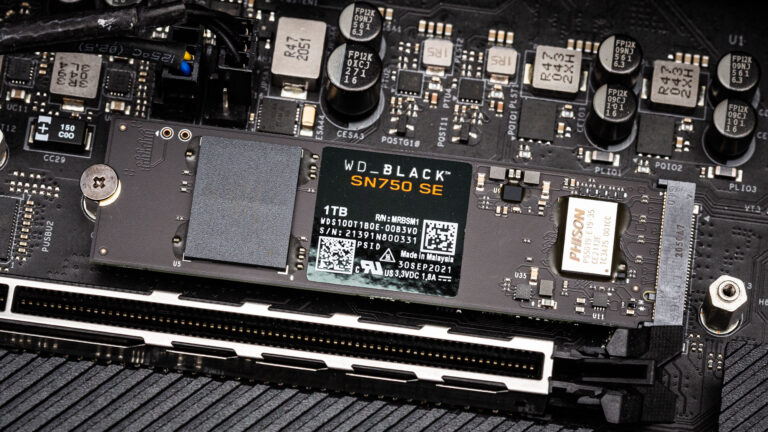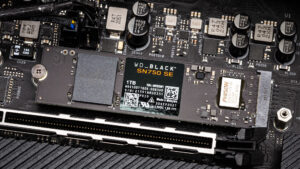So, what distinguishes the WD Black SN750 SE SSD from the competition? The emergence of a product’s ‘SE’ or ‘special edition’ version might indicate a variety of things. It’s often the final hurrah of a popular product. When a marginally better version is to exhaust the remaining component stock.
New parts, on the other hand, become available, allowing the specification to be better without affecting build costs. It’s also possible that the SE edition features special labeling or an additional feature. They planned but never added in the first product release.
What we will see here?
Price
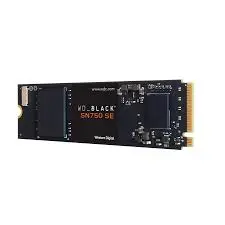
The WD Black SN750 SE SSD is only available in three capacities, compared to the five sizes available for the SN750. There are three sizes available: 250GB, 500GB, and 1TB. The 1TB version is the best value choice, costing £56.99 (US$54.99), £95.99 (US$74.99), and £156.99 (US$139.99) straight from the Western Digital Store. It’s also available on
The WD Black SN750 SE costs slightly less than the SN750 at the very same capacity. Whereas the SN750 is also accessible with a heatsink, increasing the price difference. The pricing of any Samsung 980 NVMe 1TB, which is around £120 (US$120) from
A drive with comparable performance can be gained for roughly £110 (US$115) from a famous brand, and much less from a smaller brand. What should worry Western Digital, even more, is that its own devices, such as the SanDisk SDSSDXPM2-1T00-G25 Extreme PRO, undercut the SN750 SE.
The differential between this and the 7,000MB/s PCIe 4 SN850 is a little less than £15. Putting the WD Black SN850 a better deal.
Brief of WD Black SN750 SE
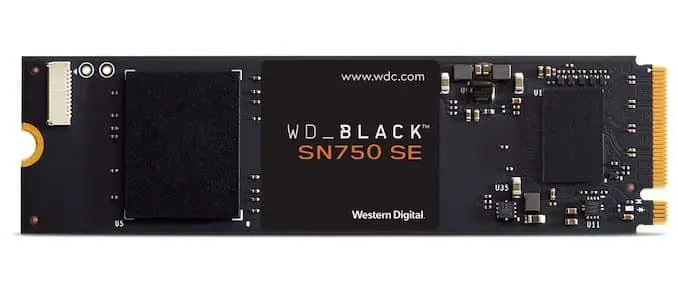
Western Digital seems to have a long and complex history using storage devices, the majority of which are dependent on spinning metal discs that store and retrieve data using magnet fields. But, like all hard drive manufacturers, it suddenly understood that the future didn’t seem to entail moving parts, and began transitioning to solid-state technology for retail and commercial clients.
The original SN750, a 2nd generation NVMe drive, was released in early 2019. It also supported a maximum of 3,470MB/s reads and 3,000MB/s writes depending on capacity. Thanks to a Western Digital controller and SanDisk 64-layer 3D TLC NAND Flash.
It’s difficult to exaggerate how superior the SN750 was to Western Digital’s first-generation NVMe drives. It improved the line so that it could compete directly with Samsung’s 970 Evo. The WD Black SN750 SE is now available, with faster sequential reading rates and a few write performance restrictions, but similar TB endurance, temperature ranges, and warranty coverage.
Build and Design

The progression of NVMe drive design has intriguing to observe, as we’ve gone from M.2 2280 sticks with a lot of separate components from both sides to drives that appear to be much simpler. There are no visible elements on the underside of the WD Black SN750 SE 1TB. Also, the top surface is covered by a single NAND package and the TSMC-fabricated 32-bit Phison PS5019-E19T controller.
This chip is a departure from the previous design, and it’s one of the reasons why, unlike the WD Black SN750, the SN750 SE only comes in 1TB, 2TB, and 4TB capacities. While the PS5019-E19T can accommodate up to 2TB and that capacity can be increased in the future. The 4TB SN750 will never be replaced.
This is really a PCIe Gen4x4 specification controller, despite the fact that the NAND module configuration prevents speeds above PCIe Gen3x4 bandwidth. The controller is a DRAM-free design that supports PCIe Gen 1, 2, 3, and 4 with the highest bandwidth possible at each level. It also has security choices for AES 256, TCG Opal, and Pyrite.
Overall, the new controller as well as the lack of any significant changes appear to be more of an optimization exercise than an upgrade overhaul.
Endurance of WD Black SN750 SE
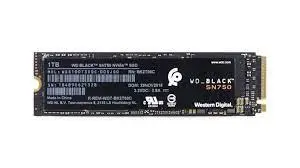
The WD Black SN750 SE offers the same level of endurance as the SN750 at the very same capacities. These values are either acceptable or too low for any given drive size, depending on how hard you use a machine.
If you don’t edit 4K footage on a regular basis, the 500GB drive’s 300TB capacity is definitely plenty, while the 250GB drive’s 200TB capacity is on the edge of what it feels comfortable operating.
The 2TB and 4TB drives only available with original SN750 parts, omitting any SN750 SE extras, are the way to go if you want the best TBW numbers.
Performance
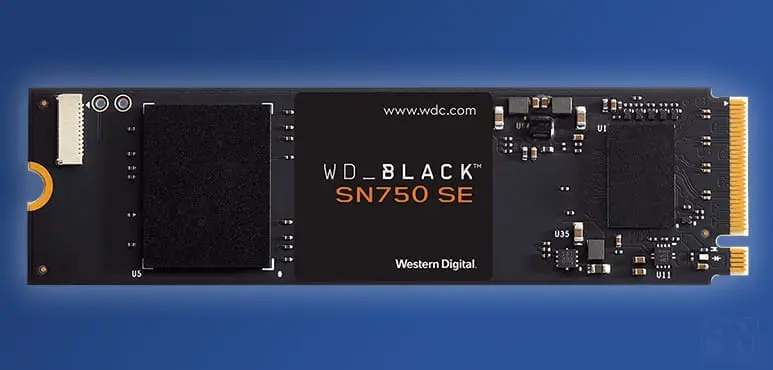
The WD Black SN750 SE (1TB model) performs very similarly to the drive it replaces. It is, however, stronger in some areas and weaker in others. Western Digital claims 3,600MB/s reads and 2,800MB/s writes for the 1TB review sample, which is nearly identical to the results that you can achieve using CrystalDiskMark 8.0.4 with default settings.
The exact read and write speeds were 3,619.17MB/s and 2,912.6MB/s, respectively, in ‘RealWorld’ mode, but they were 2,534MB/s and 2,831MB/s. The sequential reading is faster than the original SN750 1TB design, but the writing peak is substantially lower. If you are using your NVMe SSD to start the OS, start apps, and play games, the SE could be faster. If you frequently execute write operations, this is less desirable.
In its Compression Test, AS SSD got the most unusual result. This frequently results in a graph that covers total capacity, with reading and writing performance following a similar pattern at various levels. Reading, on the other hand, began at its highest point and decreases gradually along with the range, while writing began low and kept increasing.
The writing graph line was indeed choppy, as though it was constantly adjusting buffer sizes on the fly to meet the test’s needs. This isn’t a characteristic one can see before, and it could be related to the Phsion controller’s lack of DRAM.
Conclusion of WD Black SN750 SE
So, what makes the 750 SE unique? Well, it’s definitely not consecutive writing, especially on discs with smaller capacities. Customers will get confused if a company releases a “special edition” that is slower in some ways than the ordinary model. However, it is a little faster in some places, such as sequential reading, creating a confusing signal.
Price is one area where all three capacities outperform their predecessor. Although five or ten bucks may not seem like much, for individuals on a tight budget or purchasing storage for dozens of PCs, it may add up quickly.
In summary, WD noted that employing a Phsion component instead of committing engineering efforts to build NVMe controllers enables the SN750 to be made at a lower cost. They pass along part of the savings to you, the client. Did they, however, pass on enough of the savings? The answer is no when compared to Western Digital’s cheaper replacement parts sold under the SanDisk name.
Component pricing and accessibility are all over the place in the event of a pandemic. And they’re unlikely to return to normal for a long time. Western Digital, on the other hand, is being undercut on price by firms that don’t make NAND Flash in-house, which is perplexing.
Whatever the pricing justification is here, retail revisions should make the WD Black SN750 SE SSD a more appealing choice for consumers looking for inexpensive storage.


